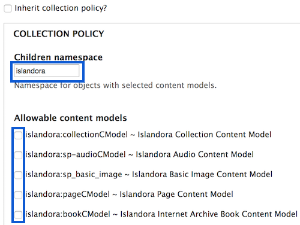...
The collection form contains five major steps:
- Collection Name - This is the name that will show up at the top of the collection's page (see 'Top-level Collection' in the first image above for an example).
- Collection PID - This is the Persistent Identifier for this new collection; check APPENDIX E - Glossary for more information on Persistent Identifiers
Inherit collection policy?- Check this box to copy the parent collection's collection policy into the new collection. This will include any content models the parent collection was using. In this example, the only content model in the top-level collection's collection policy was the 'Collection' content model. so no other unique content models will be pulled.
If the inherit collection policy box is not selected you will need to enter a Children Namespace - This is the namespace objects in the new collection will use (again, check the Glossary for more information). You may select any content models which will apply to this new collection (this will display all content models that are available in your repository).

- Inherit XACML policy from: Select from the dropdown menu if you would like to copy the XACML policy.
- Create collection - Once the form is filled out, click this button to create the collection.
5. Fill in the MODS Collection metadata form.
| Note |
|---|
| If you have the MARCXML module |
...
...
| you will be prompted to upload a MARCXML file. If you don't have a MARCXML file, you can ignore this screen and simply continue with the ingest process. |
Otherwise, the user can select Next to proceed to the metadata form. The MODS Collection metadata form allows the user to fully describe collection objects. Once the form has be filled in, the user can select Ingest to complete the creation of the new collection object.
...

